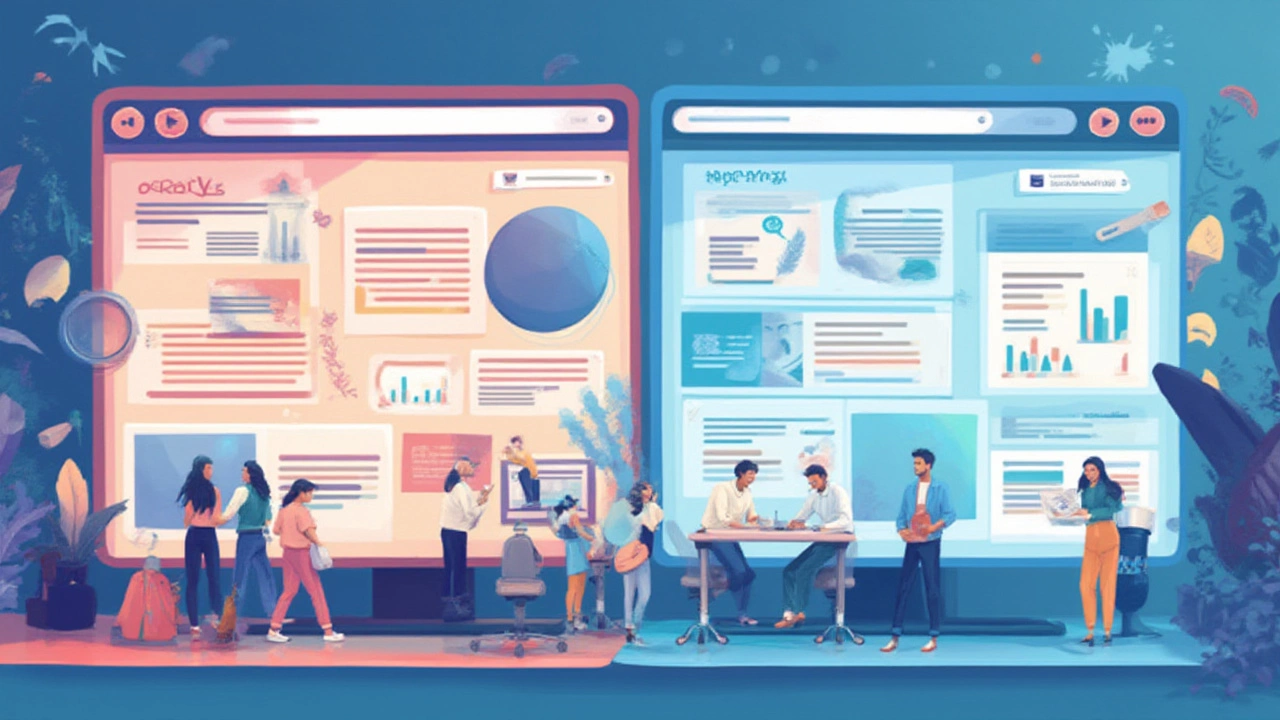Is HTML and CSS Enough for a Modern Website? What You Should Really Know
Imagine sitting in your favorite coffee shop, sketchbook open, coming up with your first website idea. You’ve typed out some HTML, painted with a few shades of CSS, and you’re feeling triumphant. But here’s where the plot thickens: Is that really all you need? Or is this just the surface of what it actually takes to launch a website people want to use?
What HTML and CSS Can (and Can’t) Do On Their Own
Dive into the timeline of the internet, and you’ll see HTML and CSS as the backbone since the early 1990s. HTML is like the skeleton—giving structure to your content. Need a heading, a paragraph, or a picture? That’s HTML. CSS? That’s the wardrobe, the paint, the tailor—making everything look good and feel right, from font choices to layouts to fancy hover effects.
So, you can most definitely make a website with just these two. In fact, those “Under Construction” pages from the past or basic portfolios you see when folks are just learning? All powered by HTML and CSS. Here’s the thing: “Static sites,” as they’re called, are totally doable with these. Think digital business cards, personal blogs, or even simple landing pages.
But what about logging in, leaving comments, filling out contact forms, or any feature that involves a user talking back to the page? That’s where things get complicated. HTML and CSS can’t process, store, or manipulate data. If you submit a contact form, for example, nothing happens—unless there’s something (or someone) on the other side to catch that info. So while you can create the look and layout, all the “soul” and smarts are missing. No login systems. No shopping carts. No dynamic content like personalized greetings or product suggestions. In short: HTML and CSS draw the house, but can’t open the door.
About 70% of all websites use more than just HTML and CSS, according to data from W3Techs. The remaining 30%? Most are parked domains or simple informational sites. Even those simple sites, though, often use extra tools like forms powered by Google or embedded YouTube videos that require more than just your basic code.
Let’s break it down in a quick table so you can size up their limits at a glance:
| Feature | HTML | CSS | Requires More |
|---|---|---|---|
| Text and Images | ✔️ | Styling only | No |
| Contact Forms | Structure | Styling | Yes, for processing |
| User Login | Structure only | Styling | Yes |
| Shopping Cart | Structure | Styling | Yes |
| Interactivity (like dropdowns) | No | Limited to hover/focus | Yes (usually JavaScript) |
| Animations | No | Basic only | Yes, for advanced |
If you’re just looking to create your own online resumé or a super-simple event page, HTML and CSS can get you there. But if you want a site that interacts with people, stores info, or gives updates based on what the user does, you’ll hit a wall pretty fast.

Next Steps After Mastering HTML and CSS
So you’ve polished your HTML, made your CSS shine, and you’re hungry for more. What’s next? The logical leap is into interactivity and dynamic magic. This is where JavaScript comes in—it’s the go-to language that turns flat sites into interactive playgrounds.
Ever wonder how clicking a button expands more content, how photo galleries slide gracefully, or how your favorite chat app keeps the conversation fresh without you refreshing the screen? That’s JavaScript working its wonders. In fact, according to the Stack Overflow Developer Survey, JavaScript has been the world’s most popular programming language for over a decade. Can HTML and CSS do this? Nope, not even with their fanciest tricks.
But it’s not just about making things move. JavaScript can talk to servers, grab data, and even handle your form submissions. That means, suddenly, your simple static page can become a tiny version of Facebook, at least functionally.
If building a blog with user comments or running even a basic online store is your goal, JavaScript (and its many libraries and frameworks like React or Vue) are practically non-negotiable.
Outside the browser, sites need to store, retrieve, and manage information. That’s where databases come in—MySQL, PostgreSQL, MongoDB are household names in developer land. Alongside that, server-side languages like PHP, Python, or Node.js handle things like logging in, posting comments, or saving images. Back in the day, when I built a site for my friend Mark’s bakery, he was surprised we needed way more than just HTML and CSS. He wanted a “Today’s Special” to show up based on what he baked each morning. That isn’t doable with HTML and CSS alone—unless you want to manually update code at 5 a.m. and hope you didn’t miss a tag.
Security is also worth mentioning. HTML and CSS don’t do anything to protect your site. If you need to keep user data safe—passwords, emails, even basic contact information—you need robust server-side logic and security practices. The second a site becomes more than a digital flyer, security matters.
Here are a few practical next steps as you work beyond static sites:
- Start learning JavaScript—focus on the basics, like variables, functions, events, and DOM manipulation.
- Explore a few popular JavaScript frameworks—React, Vue, or Svelte can make your code neater and sites faster.
- Understand server-side basics—tools like Node.js, PHP, or Python’s Django or Flask are great entry points.
- Get comfortable with databases—even simple SQLite or Firebase can give your projects new life.
- Try version control—tools like Git save you headaches and add professionalism to your workflow.
The journey from static to dynamic can feel like stepping from a quiet room into a live concert, but the reward is wild. Your sites become living, breathing things—just waiting for users to poke around.

Tips for Beginners and What Really Matters When Building a Website
Here’s the question people don’t ask enough: What’s your website actually trying to do? The answer is everything. Maybe you really do just need a clean digital business card—that’s where pure HTML and CSS rule. But if you have a vision that involves people filling in forms, creating accounts, or seeing different info every time they visit, that’s when you know you’ve outgrown the basics.
It’s easy to fall into the trap of thinking you need to learn everything before getting started. Truth? Some of the most successful personal sites out there are super simple, just well-written, and easy on the eyes. Navigation matters. Mobile-friendliness is huge—did you know that more than 63% of web traffic comes from mobile devices, according to Statista’s 2025 report? If your site isn’t responsive (which is really a CSS thing, by the way), you’re leaving out most of your potential audience.
Speed matters, too—if your site loads slowly, users disappear faster than you can say bandwidth. While HTML and CSS are lightweight, as soon as you tack on more features, it’s easy to get lost in the bloat. Tools like Google’s PageSpeed Insights or GTmetrix can help you keep things zippy. Optimize your images, clean up unused CSS, and only add extras when they matter.
If you’re not a code person but want a site fast, platforms like WordPress or Wix abstract away much of the heavy lifting. Behind the curtain, though, even those pros use HTML, CSS, and often a heap of JavaScript and server-side smarts. It’s just tucked away so you don’t have to deal with it directly.
Want to really level up? Check out browser dev tools. Right-click any page, choose “Inspect,” and see how the pros style their elements. You’ll start to see patterns—the way navigation menus collapse on mobile, the lazy loading on images, or how pop-ups appear and slide away smoothly.
Building accessibility into your site matters a ton, too—give your images alt text, make sure links and buttons are keyboard-friendly, and double-check your color contrast. Not only does this make your site better for everyone, but it also helps you in search rankings (something Fiona reminded me more than once when I was impatiently smashing through code on a school project for our son’s club).
Don’t be afraid to “view source” on your favorite sites. If you see classes or scripts or strange-looking code, look it up. Break it down. The best knowledge comes from curiosity. Even the fanciest features usually start with the basics you already know, then build layer by layer.
- Test on every device you can find—what looks great on a laptop might be a disaster on your phone.
- Use free resources like freeCodeCamp, Mozilla’s MDN Web Docs, and CSS-Tricks to sharpen your skills.
- Try building a little project for someone you know—feedback is the rocket fuel of learning.
- Don’t chase perfection—ship something, see what breaks, and fix it as you go.
Embrace the mindset that your site is never truly done. Every time you learn a new skill, circle back and improve your project. It’s not about reaching the end; it’s about getting a little better—and more creative—each time you hit "publish." HTML and CSS are where you start, but the digital world waits for what you can imagine next.





